Pen and Inkwell Old Fashioned Phone

Close-up of traditional fountain pen with an iridium-tipped stainless steel nib


Diverse contemporary and vintage fountain pens (left to right):
- Airplane pilot Justus 95
- Pelikan Souverän M1000
- Montblanc Meisterstück 149
- Pilot Heritage 912
- Parker Duofold Centennial
- Sheaffer Snorkel Admiral
- Lamy Dialog 3
- Welty
- Parker Sonnet
- Conway Stewart 55
- Waterman Thorobred
- Mabie Todd Swan 3220
A fountain pen is a writing musical instrument which uses a metal nib to apply a h2o-based ink to paper. Information technology is distinguished from before dip pens by using an internal reservoir to hold ink, eliminating the demand to repeatedly dip the pen in an inkwell during utilise. The pen draws ink from the reservoir through a feed to the nib and deposits information technology on newspaper via a combination of gravity and capillary action. Filling the reservoir with ink may be achieved manually, via the utilize of an eyedropper or syringe, or via an internal filling mechanism which creates suction (for example, through a piston mechanism) or a vacuum to transfer ink directly through the bill into the reservoir. Some pens employ removable reservoirs in the class of pre-filled ink cartridges.[1]
History [edit]
Early prototypes of reservoir pens [edit]
According to Qadi al-Nu'homo al-Tamimi (d. 974) in his Kitab al-Majalis wa 'l-musayarat, the Fatimid caliph Al-Mu'izz li-Din Allah in Arab Egypt demanded a pen that would not stain his easily or clothes, and was provided with a pen that held ink in a reservoir, allowing information technology to be held upside-down without leaking.[2]
There is compelling evidence that a working fountain pen was constructed and used during the Renaissance by artist and inventor Leonardo da Vinci. Leonardo's journals contain drawings with cross-sections of what appears to be a reservoir pen that works past both gravity and capillary action. Historians also took notation of the fact that the handwriting in the inventor'south surviving journals is of a consistent contrast throughout, rather than exhibiting the characteristic fading pattern typical of a quill pen caused by expending and re-dipping. While no physical detail survives, several working models were reconstructed in 2011 by creative person Amerigo Bombara that have since been put on display in museums dedicated to Leonardo.[3]

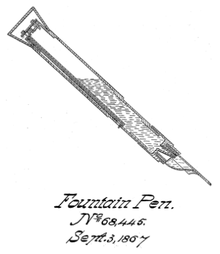
G. Klein and Henry W. Wynne received U.S. Patent 68,445 in 1867 for an ink bedchamber and delivery system in the handle of the fountain pen
European reservoir models [edit]

Deliciae physico-mathematicae, 1636
The fountain pen was available in Europe in the 17th century and is shown by contemporary references. In Deliciae Physico-Mathematicae (a 1636 magazine), German inventor Daniel Schwenter described a pen made from two quills. One quill served equally a reservoir for ink inside the other quill. The ink was sealed inside the quill with cork. Ink was squeezed through a modest pigsty to the writing bespeak.[4] In 1663 Samuel Pepys referred to a metal pen "to carry ink".[5] Noted Maryland historian Hester Dorsey Richardson (1862–1933) documented a reference to "three silver fountain pens, worth 15 shillings" in England during the reign of Charles Two, c. 1649–1685.[6] Past the early on 18th century such pens were already commonly known as "fountain pens".[7] Hester Dorsey Richardson as well found a 1734 annotation made by Robert Morris the elderberry in the ledger of the expenses of Robert Morris the younger, who was at the time in Philadelphia, for "i fountain pen".[6] Perhaps the all-time-known reference, however, is that of Nicholas Bion (1652–1733), whose illustrated description of a "plumage sans fin" was published in 1709 in his treatise published in English language in 1723 as "The Construction and Principal Uses of Mathematical Instruments". The earliest datable pen of the form described by Bion is inscribed 1702, while other examples bear French hallmarks equally late as the early on 19th century.
First patents [edit]
Progress in developing a reliable pen was slow until the mid-19th century considering of an imperfect understanding of the role that air pressure level plays in the operation of pens. Furthermore, most inks were highly corrosive and full of sedimentary inclusions. The first English patent for a fountain pen was issued in May 1809 to Frederick Fölsch, with a patent covering (among other things) an improved fountain pen feed issued to Joseph Bramah in September 1809.[ citation needed ] John Scheffer's patent of 1819 was the first pattern to see commercial success, with a number of surviving examples of his "Penographic" known. Another noteworthy pioneer pattern was John Jacob Parker's, patented in 1832 – a cocky-filler with a screw-operated piston.[8] The Romanaian inventor Petrache Poenaru received a French patent on May 25, 1827, for the invention of a fountain pen with a barrel made from a large swan quill.[nine]
Mass-manufactured nibs [edit]
In 1828, Josiah Mason improved a cheap and efficient sideslip-in beak in Birmingham, England, which could be added to a fountain pen and in 1830, with the invention of a new car, William Joseph Gillott, William Mitchell, and James Stephen Perry devised a way to mass manufacture robust, cheap steel pen nibs (Perry & Co.).[10] This boosted the Birmingham pen trade and by the 1850s, more one-half the steel-nib pens manufactured in the world were made in Birmingham. Thousands of skilled craftsmen were employed in the industry.[xi] Many new manufacturing techniques were perfected, enabling the metropolis's factories to mass-produce their pens cheaply and efficiently. These were sold worldwide to many who previously could not afford to write, thus encouraging the evolution of didactics and literacy.[12]
New patents and inventions [edit]
In 1848, American inventor Azel Storrs Lyman patented a pen with "a combined holder and nib".[xiii] From the 1850s, at that place was a steadily accelerating stream of fountain pen patents and pens in product. Nevertheless, information technology was only afterwards three key inventions were in place that the fountain pen became a widely pop writing musical instrument. Those were the iridium-tipped gold nib, difficult rubber, and costless-flowing ink.[9]

Waterman 42 Safe Pen, with variation in materials (both red and black difficult vulcanized rubbers or ebonite) and retracting nibs

The first fountain pens making utilize of all these fundamental ingredients appeared in the 1850s. In the 1870s Duncan MacKinnon, a Canadian living in New York City, and Alonzo T. Cross of Providence, Rhode Isle, created stylographic pens with a hollow, tubular beak and a wire acting equally a valve.[14] [xv] Stylographic pens are now used mostly for drafting and technical drawing simply were very popular in the decade outset in 1875. In the 1880s the era of the mass-produced fountain pen finally began. The dominant American producers in this pioneer era were Waterman, of New York City, and Wirt, based in Bloomsburg, Pennsylvania. Waterman soon outstripped Wirt, forth with many companies that sprang upwardly to fill the new and growing fountain pen market. Waterman remained the market leader until the early 1920s.[16]
At this time, fountain pens were about all filled by unscrewing a portion of the hollow barrel or holder and inserting the ink by means of an eyedropper – a slow and messy procedure. Pens also tended to leak inside their caps and at the joint where the butt opened for filling.[17] Now that the materials' bug had been overcome and the menstruation of ink while writing had been regulated, the side by side problems to be solved were the creation of a simple, user-friendly self-filler and the trouble of leakage. In 1890, West. B. Purvis patented a self-filler. Self-fillers began to get in effectually the plough of the century; the most successful of these was probably the Conklin crescent-filler, followed by A. A. Waterman'southward twist-filler.[18] [19] The tipping point, still, was the runaway success of Walter A. Sheaffer's lever-filler, introduced in 1912,[xx] paralleled by Parker'southward roughly gimmicky push button-filler.
Pen leakage [edit]
Meanwhile, many inventors turned their attention to the problem of leakage.[21] Some of the earliest solutions to this trouble came in the grade of a "prophylactic" pen with a retractable bespeak that immune the ink reservoir to be corked like a bottle. The well-nigh successful of these came from Francis C. Brown of the Caw's Pen and Ink Co. and from Morris W. Moore of Boston.[22]
In 1898, George Safford Parker released the Parker Jointless, named so considering its barrel was single-slice to preclude leakage. The section assembly fit into the pen's finish like a cork stopper; any leaked ink was kept within the beak.[23]

"Waterman's ideal fountain pen" 1908 ad
In 1908, Waterman began marketing a popular safety pen of its own.[24] For pens with non-retractable nibs, the adoption of spiral-on caps with inner caps that sealed around the pecker by begetting against the forepart of the section effectively solved the leakage problem (such pens were as well marketed every bit "safety pens", every bit with the Parker Jack Knife Prophylactic and the Swan Safety Spiral-Cap).[25] [26]
Further innovation [edit]

Lever filler pen made of celluloid past Mabie Todd & Co. New York (1927)
In Europe, the German supplies company which came to be known as Pelikan was started in 1838, and they kickoff introduced their pen in 1929.[27] This was based upon the acquisition of patents for solid-ink fountain pens from the factory of Slavoljub Penkala from Croatia (patented 1907, in mass production since 1911), and the patent of the Hungarian Theodor Kovacs for the mod piston filler by 1925.[28]
The decades that followed saw many technological innovations in the manufacture of fountain pens. Celluloid gradually replaced difficult rubber, which enabled production in a much wider range of colors and designs.[29] At the aforementioned time, manufacturers experimented with new filling systems. The inter-war period saw the introduction of some of the most notable models, such as the Parker Duofold[30] and Vacumatic,[31] Sheaffer's Lifetime Rest series,[32] and the Pelikan 100.[33]
During the 1940s and 1950s, fountain pens retained their dominance: early on ballpoint pens were expensive, were prone to leaks and had irregular inkflow, while the fountain pen connected to benefit from the combination of mass product and craftsmanship. (Bíró's patent, and other early patents on brawl-point pens ofttimes used the term "brawl-point fountain pen," because at the time the brawl-point pen was considered a type of fountain pen; that is, a pen that held ink in an enclosed reservoir.)[34] This period saw the launch of innovative models such as the Parker 51, the Aurora 88, the Sheaffer Snorkel, and the Eversharp Skyline and (later) Skyliner, while the Esterbrook J series of lever-fill models with interchangeable steel nibs offered cheap reliability to the masses.[35] [36]
Popular usage [edit]

Lamy 2000 piston filler made of polycarbonate and stainless steel, launched in 1966 and yet in product
By the 1960s, refinements in ballpoint pen product gradually ensured its dominance over the fountain pen for casual use.[37] Although cartridge-filler fountain pens are still in common use in French republic, Italy, Deutschland, Austria, Republic of india, and the United Kingdom, and are widely used by young students in virtually private schools in England, at least i private school in Scotland,[38] and public uncomplicated schools in Germany,[39] a few modern manufacturers (especially Montblanc, Graf von Faber-Castell, and Visconti) now describe the fountain pen as a collectible item or a status symbol, rather than an everyday writing tool.[40] Even so, fountain pens go on to take a growing post-obit amid many who view them as superior writing instruments due to their relative smoothness and versatility. Retailers continue to sell fountain pens and inks for casual and calligraphic use. Recently, fountain pens accept fabricated a resurgence, with many manufacturers of fountain pens saying sales are climbing. This has led to a new moving ridge of casual use fountain pens and custom ink manufacturers, who utilize online stores to easily sell fountain pens to a wider audition.[41]
Feed [edit]
The feed of a fountain pen is the component that connects the neb of the pen with its ink reservoir.[42]
It not simply allows the ink to flow to the nib (in what is oft described every bit a "controlled leak") only also regulates the corporeality of air flowing backwards up to the reservoir to replace this lost ink.[43]
Information technology does this through the apply of a series of narrow channels or "fissures" that run down its lower edge. As ink flows downwards these fissures, air is simultaneously allowed to flow upwards into the reservoir in an even exchange of volumes. The feed allows ink to menstruum when the pen is beingness put to paper but ensures ink does non flow when the pen is not in utilize. The feed makes apply of capillary activeness; this is noticeable when a pen is refilled with a brightly coloured ink. The ink is taken upward and into the feed by way of capillary action (and is often visible in articulate demonstrator pens), but is non dispensed onto the paper until the nib makes contact.[42]
How the feed is shaped may determine the wetness and flow of a item pen. For this reason, feed fabric alone and its surface roughness may have a significant event on the fashion two pens of the same pecker size write.[44] [45]
Pen feeds are crucial to preventing ink from dripping or leaking. Feeds often characteristic finned structures intended for buffering fountain pen ink. Buffering is the capacity to grab and temporarily concord an overflow of ink, caused by conditions other than writing. When a fountain pen nib receives such an overflow it will result in ink blobbing or dripping also known every bit burping. A pen with a misconfigured feed might neglect to deposit any ink whatsoever.[46]
Fiber feeds [edit]
Some fountains pens use a fiber wick underneath the nib. They often have a plastic function that looks like a feed that is only used to hold the fiber wick in place and does not help with ink flow. The mechanism of action is like a felt pen, just with a fountain pen bill on top of it. The fiber feeds offering plenty of ink period and can stay wet for extended periods. Cleaning fiber feed pens tin can require longer soaking in water.
Nibs [edit]
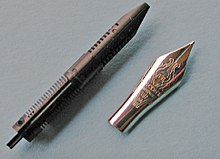
Item of a Visconti stainless steel nib and feed with a finned ink buffering structure at its rear one-half

Tip of a fountain pen nib
According to Mathur et al., "the modern fountain pen nib may exist traced back to the original gold bill which had a tiny fragment of ruby attached to form the wear-point."[47] Following the discovery of the platinum group of metals which include ruthenium, osmium, and iridium, "a minor quantity of iridium was isolated and used on the iridium-tipped gold dip pen nibs of the 1830s."[47] Today, nibs are normally made of stainless steel or gold alloys, with the about popular gilded content being 14 carat (58⅓%) and 18 carat (75%).[48] Titanium is a less common metal used for making nibs. Aureate is considered the optimum metal for its flexibility and its resistance to corrosion, although gilt's corrosion resistance is less of an issue than in the by because of better stainless steel alloys and less corrosive inks.[48] Visconti used to employ nibs made out of palladium, as it acts like gold, but have now changed to using gold for well-nigh of their nibs as information technology is easier to source.
Bill plating [edit]
Further golden plating provides favorable wettability, which is the power of a solid surface to reduce the surface tension of a liquid in contact with it such that it spreads over the surface.[49]
Nib tipping [edit]
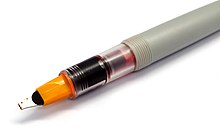
The Pilot Parallel, an example of a type of an italic bill used in fountain pens, ofttimes used to create art and calligraphy. This pen has two apartment plates that meet in the center in identify of a traditional nib.
Gold and nigh steel and titanium nibs are tipped with a hard, wear-resistant alloy that typically includes metals from the platinum group. These metals share qualities of extreme hardness and corrosion resistance. The tipping material is often called "iridium", only there are few, if any, beak or pen manufacturers that used tipping alloys containing iridium metal since the mid-1950s.[50] The metals osmium, rhenium, ruthenium, and tungsten are used instead, by and large as an alloy, with a little scrap of osmium, rhenium, ruthenium, and tungsten in a mix of other materials, produced as tiny pellets which are soldered or welded onto a nib tip prior to cutting the nib slit and grinding the tip into its last shape.[51] Untipped steel and titanium points will wear more than rapidly due to abrasion by the newspaper.[48]
Capillary action [edit]
The beak unremarkably has a tapering or parallel slit cut down its center, to convey the ink down the nib by capillary action, every bit well as a "breather pigsty" of varying shape.[52] The breather pigsty has no actual function regarding controlling the ink or air flow. Its main function is to provide an endpoint to the nib slit and preclude inaccuracies during nib slit cutting. Calculation distance between the breather hole and the nib tip adds elasticity or flexibility to the nib. The breather pigsty besides acts as a stress relieving point, preventing the nib from peachy longitudinally from the end of the slit as a result of repeated flexing during employ.[42]
The whole nib narrows to a point where the ink is transferred to the paper. Broad calligraphy pens may accept several slits in the beak to increment ink menstruum and aid distribute it evenly across the broad point. Nibs divided into 3 'tines' are commonly known as music nibs. This is because their line, which can be varied from broad to fine, is suited for writing musical scores.[53]
Types of nibs [edit]
Although the most common nibs end in a round signal of various sizes (extra fine, fine, medium, broad), various other nib shapes are available. Examples of this are double broad, music, oblique, opposite oblique, stub, italic, and 360-degree nibs.[52]
Broader nibs are used for less precise emphasis, with the benefit of a greater level of ink shading, a property wherein ink pools in parts of a stroke to cause variations in color and/or sheen, a property where dyes in ink crystallize on a page instead of absorbing into the newspaper, which leads to a different color being seen due to thin movie interference, on less absorbent paper. Finer nibs (due east.yard. actress fine and fine) may be used for intricate corrections and alterations, at the expense of shading and sheen. Oblique, contrary oblique, stub, and italic nibs may be used for calligraphic purposes or for full general handwritten compositions. The line width of a particular beak may vary based on its land of origin; Japanese nibs are oftentimes thinner in general.[54]
Nib flexibility [edit]
Flexibility is given to nibs in several ways. Offset, the thickness of the nib metal changes flex. When the bill alloy has been pressed thick it will consequence in a hard beak, while thinly pressed nibs are more flexible. Nibs can exist pressed and so that they are thinner at the tip and thicker at the feed to mitigate stiffness or to give a more than controlled flex. 2d, the curve of the nib determines in part how stiff the bill will exist.[55]
Nibs pressed into more deeply convex curves, or into three or v faceted curves, will be stiffer than flatter nibs. Third, the "sabbatical hole" size, shape, and position change the stiffness. Heart-shaped holes will meliorate flex equally they widen, while circular, small holes stiffen the pen. Fourth, the length of the tines determines how far they can spread under pressure, shorter tines make a stiffer nib. 5th, the alloy used can bear on stiffness: equally mentioned before, gold is considered superior for its flex compared to steel. Moreover, purer gold (18k and 21k) is softer than about lower golden concentration (14k) alloys.[48]
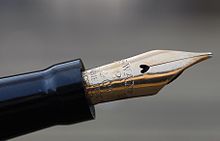
Mabie Todd Swan flexible 14k bill
Fountain pens dating from the first half of the 20th century are more likely to have flexible nibs, suited to the favored handwriting styles of the menstruum (e.yard. Copperplate script and Spencerian script). By the 1940s, writing preferences had shifted towards stiffer nibs that could withstand the greater pressure required for writing through carbon paper to create duplicate documents.[56]
Furthermore, competition betwixt the major pen brands such as Parker and Waterman, and the introduction of lifetime guarantees, meant that flexible nibs could no longer be supported profitably. In countries where this rivalry was non present to the same caste, such as the UK and Frg, flexible nibs are more common.[57]
Present, stiff nibs are the norm as people exchange between fountain pens and other writing modes. These more closely emulate the ballpoint pens nearly modern writers are experienced with. Despite being rigid and business firm, the thought that steel nibs write "horribly" is a misconception.[58] More flexible nibs tin can exist hands damaged if excessive pressure is practical to them. Ideally, a fountain pen's nib glides across the newspaper using the ink equally a lubricant, and writing requires no pressure level.
Skillful quality nibs that have been used appropriately are long lasting, often lasting longer than the lifetime of the original owner. Many vintage pens with decades-old nibs can notwithstanding be used today.[59]
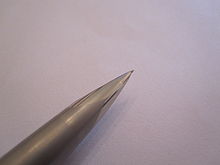
The Integral Nib of a Parker 50 (Falcon)
Different nib styles [edit]
Other styles of fountain pen nibs include hooded (e.g. Parker 51, Parker 61,[sixty] 2007 Parker 100,[61] Lamy 2000,[62] and Hero 329),[63] [64] inlaid (e.1000. Sheaffer Targa or Sheaffer P.F.Grand) or integral Nib (Parker T-1, Falcon, and Pilot Myu 701), which may too exist ground to have different writing characteristics.[65]
Users are ofttimes cautioned not to lend or borrow fountain pens as the bill "wears in" at an angle unique to each individual person.[57] A different user is likely to find that a worn-in nib does non write satisfactorily in their hand and, furthermore, creates a second wear surface, ruining the nib for the original user. This, still, is not a point of concern in pens with modern, durable tipping textile, as these pens take many years to develop any significant habiliment.[57]
Filling mechanisms [edit]

Left to Right: Gama Supreme eyedropper, Jinhao 159, and X750 using international standard converters or ink cartridges and Lamy Studio stainless and Nexx 1000 using proprietary Lamy converters or ink cartridges

Eyedropper filler [edit]
The reservoirs of the earliest fountain pens were mostly filled by eyedropper. This was a cumbersome and potentially messy process, which led to the commercial evolution of alternative methods that quickly dominated the manufacture.[17] Still, newer, more convenient filling mechanisms have never entirely displaced "eyedropper-filling" pens in the market, and they remain widely manufactured today. For some the simplicity of the mechanism, coupled with the big volume of ink it can encapsulate, compensates for the inconvenience of ink transfer.[17]
Afterward the eyedropper-filler era came the offset generation of mass-produced self-fillers, virtually all using a rubber sac to agree the ink. The sac was compressed and and then released by various mechanisms to fill the pen.[66]
Self-filling designs [edit]
The Conklin crescent filler, introduced c. 1901, was i of the kickoff mass-produced cocky-filling pen designs. The crescent filling system employs an curvation-shaped crescent attached to a rigid metal pressure bar, with the crescent portion protruding from the pen through a slot and the force per unit area bar inside the barrel. A 2nd component, a C-shaped hard rubber band, is located between the crescent and the barrel.[67]
Ordinarily, the ring blocks the crescent from pushing down. To fill the pen, one merely turns the band around the barrel until the crescent matches up to the pigsty in the ring, allowing one to push downward the crescent and squeeze the internal sac.[68]
Several other filling mechanisms were introduced to compete, such as the coin-filler (where a coin or 'medallion' was supplied along with the pen), match-filler (using a matchstick) and a 'blow-filler' which unsurprisingly required the pen owner to blow into the barrel to depress the internal sac.[1]
Piston filling innovation [edit]
In 1907, Walter A. Sheaffer patented the Lever filler, using a hinged lever gear up into the pen barrel which pressed downwardly onto a bar which in turn compressed the condom sac within, creating a vacuum to strength ink into the pen. Introduced in 1912, this innovation was rapidly imitated by the other major pen makers. Parker introduced the push button filler, which had a button hidden beneath a blind cap on the end of the barrel; when pressed, information technology acted on a pressure bar inside to depress the ink sac.[20]
Following the crescent filler came a serial of systems of increasing complication, reaching their apogee in the Sheaffer Snorkel, introduced in 1952. The Sheaffer "Snorkel" organization filled the ink sac through a retractable tube to a higher place and behind the pen point. This eliminated the need to dunk the point in ink, and the subsequent need to wipe it.[69] With the advent of the modern plastic ink cartridge in the early 1950s, though, well-nigh of these systems were phased out in favour of convenience (only reduced capacity).
Screw-mechanism piston-fillers were made equally early on every bit the 1820s, simply the mechanism's modern popularity begins with the original Pelikan of 1929, based upon a Croatian patent. The basic idea is unproblematic: turn a knob at the cease of the pen, and a screw machinery draws a piston up the barrel, sucking in ink. Thus they were easier to fill up, and pens with this mechanism remain very popular today. Some of the earlier models had to dedicate every bit much every bit half of the pen length to the machinery.[70] The advent of telescoping pistons has improved this; the Touchdown Filler was introduced by Sheaffer in 1949. It was advertised as an "Exclusive Pneumatic Down-stroke Filler."[71]
To fill it, a knob at the finish of the butt is unscrewed and the attached plunger is drawn out to its full length. The neb is immersed in ink, the plunger is pushed in, compressing and then releasing the ink sac past means of air pressure. The nib is kept in the ink for approximately x seconds to let the reservoir to fill. This mechanism is very closely modeled after a similar pneumatic filler introduced by Chilton over a decade earlier.[72]
Modern filling mechanisms [edit]

Schmidt K5 piston-style standard international size fountain pen converter, containing a user inserted 2.5 mm diameter Marine grade 316 stainless steel begetting ball
A capillary filling system was introduced by Parker in the Parker 61 in 1956.[73] In that location were no moving parts: the ink reservoir within the barrel was open at the upper end, but contained a tightly rolled length of slotted, flexible plastic. To fill up, the barrel was unscrewed, the exposed open end of the reservoir was placed in ink and the interstices of the plastic sheet and slots initiated capillary activeness, drawing up and retaining the ink. The exterior of the reservoir was coated with Teflon, a repellent chemical compound that released excess ink as it was withdrawn. Ink was transferred through a further capillary tube to the pecker. No method of flushing the device was offered, and because of problems from clogging with dried and hardened ink, production was eventually stopped.[74]
Effectually the twelvemonth 2000, Pelikan introduced a filling system involving a valve in the blind end of the pen, which mates with a specially designed ink bottle.[75] Thus docked, ink is then squeezed into the pen barrel (which, defective any mechanism other than the valve itself, has nigh the chapters of an eyedropper-fill pen of the same size). This system had been implemented simply in their "Level" line, which was discontinued in 2006.[75]
Nigh pens today utilise either a piston filler, squeeze-bar filler or cartridge.[ane] Many pens are also uniform with a converter, which has the same plumbing equipment as the pen's cartridge and has a filling mechanism and a reservoir fastened to it.[1] This enables a pen to fill either from cartridges or from a bottle of ink. The most common type of converters are piston-manner, just many other varieties may be found today. Piston-style converters generally take a transparent round tubular ink reservoir. Fountain pen inks feature differing surface tensions that can cause an ink to adhere or "stick" against the within of the reservoir. Mutual solutions for this problem are adding a pocket-size (rust-proof) ink agitating object like a 316 or 904L stainless steel or zirconium dioxide bearing ball, spring or hollow tube in the tubular reservoir to mechanically promote free movement of the independent ink and ink/air exchange during writing. Calculation a very small corporeality of surfactant such every bit Triton 10-100 used in Kodak Photo-Flo 200 wetting agent to the ink volition chemically promote free movement of the independent ink and ink/air exchange during writing. However, ink might react adversely to adding a surfactant.
Vacuum fillers, such as those used by Airplane pilot in the Custom 823, utilize air force per unit area to fill the ink bedroom. In this example, while the bill is submerged in ink, a plunger is pushed down the empty chamber to create a vacuum in the space behind it. The end of the chamber has a section wider than the rest, and when the plunger passes this point, the deviation in air pressure in the area behind the plunger and the area ahead of it is suddenly evened out and ink rushes in backside the plunger to fill the bedchamber.[76]
Cartridges [edit]
A patent for an ink cartridge organization for fountain pens was filed in 1890. In the early 20th century, cartridges were made from glass and thin copper tubing. However, the concept only became successful and pop afterward the introduction of moulded plastic cartridges, firstly past Waterman in 1953.[77] Modern plastic cartridges can comprise small ridges on the within to promote free move of the contained ink and ink/air commutation during writing. Often cartridges are closed with a pocket-sized brawl that gets pressed into the cartridge during insertion into the pen. This ball also aids complimentary movement of the contained ink.
Standard international [edit]

Dimensions of short International Ink Cartridge
Most European fountain pen brands (for example Caran d'Ache, Faber-Castell, Michel Perchin, DuPont, Montegrappa, Stipula, Pelikan, Montblanc, Europen, Monteverde, Sigma, Delta, Italix, and Rotring) and some pen brands of other continents (for example Acura, Bexley, Retro51, Tombow, and Platinum (with adaptor)) utilise so called "international cartridges" (AKA "European cartridges" or "standard cartridges" or "universal cartridges"), in short (38 mm in length, about 0.75 ml of chapters) or long (72 mm, 1.l ml) sizes, or both. It is to some extent a standard, then the international cartridges of whatsoever manufacturer tin can be used in about fountain pens that accept international cartridges.[78]
Likewise, converters that are meant to replace international cartridges can be used in most fountain pens that accept international cartridges. Some very compact fountain pens (for example Waterman Ici et La and Monteverde Diva) take only short international cartridges.[79] Converters can not exist used in them (except for so-called mini-converters by Monteverde). Some pens (such as the modernistic Waterman models) have intentional fittings which prevent the usage of short cartridges. Such pens can only take a proprietary cartridge from the same manufacturer, in this instance the long Waterman cartridges.[80]
Proprietary offerings [edit]
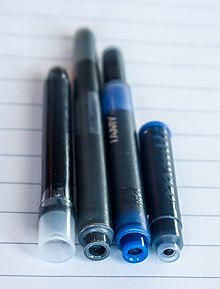
Proprietary cartridges (left to correct): Airplane pilot, Parker, Lamy, short standard international (made past Kaweco)
Many fountain pen manufacturers have developed their own proprietary cartridges, for instance Parker, Lamy, Sheaffer, Cross, Crewman, Platinum, Platignum, Waterman, and Namiki. Fountain pens from Aurora, Hero, Duke, and Uranus accept the same cartridges and converters that Parker uses and vice versa (Lamy cartridges, though not officially, are known to interchange with Parker cartridges also). Cartridges of Aurora are slightly unlike from cartridges past Parker.[81]
Corresponding converters to be used instead of such proprietary cartridges are usually made past the same visitor that made the fountain pen itself. Some very compact fountain pens accept only proprietary cartridges fabricated by the same visitor that made that pen, such every bit Sheaffer Agio Compact and Sheaffer Prelude Compact. It is non possible to use a converter in them at all. In such pens the but practical way to apply some other brand of ink is to make full empty cartridges with bottled ink using a syringe.[81]
Standard international cartridges are airtight by a small ball, held within the ink leave hole by gum or by a very thin layer of plastic. When the cartridge is pressed into the pen, a small-scale pivot pushes in the ball, which falls inside the cartridge. The Parker and Lamy cartridges do non accept such a ball. They are closed by a slice of plastic, which is cleaved past a sharp pin when inserted in the pen.[78]
Concerns and alternatives [edit]
Pen manufacturers using a proprietary cartridge (which in almost all cases are the more expensive ones like the ones mentioned above) tend to discourage the use of cheaper[82] internationally standardised short/long cartridges or adaptations thereof due to their variance in ink quality in the cartridges which may not offer as much performance, or exist of lesser quality than the manufacturer of the pen; ink that has been designed specifically for the pen. In addition, cheaper ink tends to have longer to dry on paper, may skip or produce uneven colour on the page and be less "tolerant" on lower, thinner grades of paper (e.g. 75gs/m).[82]
While cartridges are mess-free and more user-friendly to refill than canteen filling, converter and bottle filling systems are still sold. Non-cartridge filling systems tend to be slightly more than economic in the long run since ink is generally less expensive in bottles than in cartridges. Advocates of bottle-based filling systems also cite less waste of plastic for the environment, a wider selection of inks, easier cleaning of pens (as drawing the ink in through the nib helps dissolve old ink), and the ability to check and refill inks at whatsoever fourth dimension.[83]
Inks [edit]
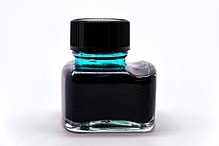
Inks intended for use with fountain pens are water-based. These inks are commonly available in bottles. Plastic cartridges came into use in the 1960s, but bottled inks are still the mainstay for most fountain pen enthusiasts. Bottled inks usually cost less than an equivalent amount in cartridges and afford a wider multifariousness of colors and properties.[84]
Fountain pens are not equally tightly coupled with their inks as ballpoints or gel pens are, yet some care must be taken when selecting their inks. Contemporary fountain pen inks are almost exclusively dye-based because pigment particles usually clog the narrow passages.[84] [83]
Traditional iron gall inks intended for dip pens are non suitable for fountain pens as they will corrode the pen (a phenomenon known as flash corrosion) and destroy the functionality of the fountain pen.[82] Instead, modern surrogate atomic number 26 gall formulas are offered for fountain pens. These modern iron gall inks contain a small amount of ferro gallic compounds, but are gentler for the inside of a fountain pen, but tin still exist corrosive if left in the pen for a long period.[82] To avoid corrosion on delicate metallic parts and ink clogging a more thorough than usual cleaning regime – which requires the ink to be flushed out regularly with water – is sometimes advised by manufacturers or resellers.[85]
Some pigmented inks exercise exist for fountain pens, such as "Carbon Black" made by the brand Platinum, but these are uncommon. Normal Republic of india ink cannot be used in fountain pens considering information technology contains shellac as a binder which would very quickly clog such pens.[86]
Inks ideally should be fairly free-flowing, costless of sediment, and not-corrosive, though this generally excludes permanence and prevents large-scale commercial use of some colored dyes. Proper care and selection of ink volition prevent most bug.[82]
Today [edit]
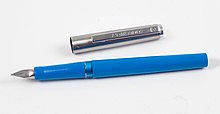
A 1970s model metal and plastic fountain pen

The Airplane pilot Varsity, an inexpensive disposable fountain pen
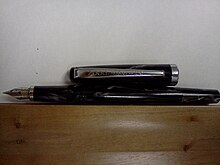
A modern celluloid fountain pen fitted with a vintage neb
While no longer the primary writing musical instrument in modern times, fountain pens are nevertheless used for important official works such as signing valuable documents.[87] Today, fountain pens are frequently treated equally luxury goods and sometimes every bit condition symbols. Fountain pens may serve as an everyday writing instrument, much like the mutual ballpoint pen.[57] Good quality steel and gold pens are available inexpensively today, especially in Europe and China, and there are "disposable" fountain pens such every bit the Pilot Varsity. In French republic and Germany, in particular, the utilise of fountain pens is widespread. To avoid mistakes, special ink tin can exist used that tin exist fabricated invisible by applying an ink eraser.
Fountain pens can serve various artistic purposes such equally expressive penmanship and calligraphy, pen and ink artwork, and professional fine art and design. Many users as well favor the air of timeless elegance, personalization, and sentimentality associated with fountain pens,[88] which computers and ballpoint pens seem to lack,[89] and frequently state that once they start using fountain pens, ballpoints get awkward to utilise due to the extra motor effort needed and lack of expressiveness.
For ergonomics, fountain pens may salve physiological stress from writing; alternatives such every bit the ballpoint pen can induce more than pain and harm to those with arthritis. Some also believe they could improve academic performance.[90] In some countries, fountain pens are usual in lower school grades, believed to teach children amend command over writing as many common mistakes of people not used to handwriting (like also much force per unit area or incorrect hold) experience unnatural or are about impossible when using traditional pen tips.[91]

A modern fountain pen, writing in cursive script
Some fountain pens are treated equally collectibles. Ornate pens may be made of precious metals and jewels with cloisonné designs. Some are inlaid with lacquer designs in a procedure known as maki-e.[92] Gorging communities of pen enthusiasts collect and use antiquarian and mod pens and also collect and exchange data most old and modern inks, ink bottles, and inkwells. Collectors may decide to use the antiques in addition to showcasing them in airtight spaces such as glass displays.[93]
News outlets report that, rather than declining, fountain pen sales have been steadily rising over the last decade.[94] At that place is a clear resurgence in the appeal and civilisation of the fountain pen, whether for purposes of collection, enjoyment or equally a "lifestyle item".[95] Many concord that the "personal touch" of a fountain pen has led to such a resurgence with modern consumers looking for an culling in a world of digital products and services.[96]
Amazon reported "sales and then far this yr [2012] take doubled compared with the same period in 2011. They are four times higher than 2010."[94] The popularity of fountain pens continues to show growth. The market-research firm Euromonitor reported that fountain pen retail sales were upwards ii.1% in 2016 from a year earlier, reaching $1.046 billion.[97]
Run across also [edit]
- Demonstrator pen
- Fountain pen inks
- Inkwell
- IAMPETH
- Category: Fountain pen and ink manufacturers
- List of pen types, brands and companies
- Listing of terms almost pen and ink
Notes and references [edit]
- ^ a b c d Binder, Richard. "Filling Systems: Overview of How They Work and How to Fill up Them". Richard Binder's Pens . Retrieved 26 July 2016.
- ^ Bosworth, C. East. (1981). "A Mediaeval Islamic Prototype of the Fountain Pen?". Journal of Semitic Studies. 26 (ane): 229–234. doi:10.1093/jss/26.ii.229.
...not more than a few days passed earlier the craftsman, to whom the construction of this contrivance had been described, brought in the pen, fashioned from golden. He and then filled information technology with ink and wrote with it, and it actually did write. The pen released a little more ink than was necessary. Hence al-Mu'izz ordered that it should be adapted slightly, and he did this. He brought forward the pen and behold, it turned out to be a pen which can be turned upside down in the hand and tipped from side to side, and no trace of ink appears from it. When a secretary takes up the pen and writes with it, he is able to write in the most elegant script that could possibly be desired; then, when he lifts the pen off the sheet of writing textile, it holds in the ink. I observed that information technology was a wonderful slice of work, the similar of which I had never imagined I would always see.
- ^ "La penna di Leonardo alla sala regia". Tusciaweb.european union (in Italian). September 7, 2011. Retrieved 2016-11-09 .
- ^ Schwenter, Daniel, Deliciae physico-mathematicae … (Nürnberg, (Germany): Jeremias Dümler, 1636), vol. 1, pp. 519–520 "Dice III Auffgab. Ein schön Underground, eine Feder zu zurichten, welche Dinten hält, und so viel lässet als human being bedürfftig." (The third practice. A nice hole-and-corner: to prepare a pen which holds ink and lets [flow] every bit much as ane requires. [with analogy])
- ^ Pepys, Samuel (August 1663). Diary entries from August 1663 (Pepys' Diary). Samuel Pepys. Retrieved 27 July 2016.
- ^ a b Richardson, Hester Dorsey (1913). "Chapter XLVII: The Fountain Pen in the Time of Charles Two". Side-lights on Maryland History, with Sketches of Early on Maryland Families. Baltimore, Md.: Williams & Wilkins Co. pp. 216–17. ISBN0-8063-1468-0.
- ^ Matthew Henry, Commentary on the Whole Bible, Zechariah iv. ii (1710), describing a type of self-replenishing oil lamp: "Without any farther Care they [i.e. the lamps] received Oil every bit fast as they wasted information technology, ('as in those which we call Fountain Inkhorns, or Fountain Pens')".
- ^ "Who Invented The Fountain Pen?". Vintage Pens . Retrieved 10 Jan 2019.
- ^ a b "Who Invented The Fountain Pen?". Best Fountain Pen. 2015-01-05. Archived from the original on 2016-10-07. Retrieved 27 July 2016.
- ^ "Perry and Co". Grace's Guide . Retrieved 27 July 2016.
- ^ "Birmingham Heritage". www.birminghamheritage.org.uk . Retrieved 27 July 2016.
- ^ "The Manufacture of Steel Pens in Birmingham". The Illustrated London News. 18 (471). 22 February 1851.
- ^ The Times (London, England), 15 September 1885, p. 6: Obituary
- ^ "Stylographic Pens". Vintage Pens . Retrieved 27 July 2016.
- ^ Scientific American, "Fountain Pens". Munn & Company. 1878-08-10. p. 80.
- ^ Binder, Richard. "Significant Pens of the Twentieth Century". Richard Binder'southward Pens . Retrieved 27 July 2016.
- ^ a b c Folder, Richard. "Filling System Histories: Here's Mud in Your Eye(dropper)". Richard Binder's Pens . Retrieved 26 July 2016.
- ^ "Filling Instructions: Twist-Fillers". Vintage Pens . Retrieved 27 July 2016.
- ^ "Crescent Filler". His Nibs . Retrieved 27 July 2016.
- ^ a b Binder, Richard. "Filling System Histories: Lever Expect Back". Richard Binder's Pens . Retrieved 26 July 2016.
- ^ Binder, Richard. "Fillers: Wring It Out!". Richard Binder's Pens . Retrieved 27 July 2016.
- ^ "Safety Pens". Vintage Pens.
- ^ "Eye-Joint, End-Joint & 'Jointless' Eyedroppers". www.vintagepens.com . Retrieved 11 March 2017.
- ^ "Waterman Safeties". Vintage Pens.
- ^ Binder, Richard. "Design Features: Safety Pens". Richard Folder'south Pens . Retrieved 27 July 2016.
- ^ "The Mabie Todd Swan Prophylactic Screw Cap Eyedropper Filler". Good Writers' Pens. 7 May 2011. Retrieved 27 July 2016.
- ^ Propas, Rick. "The PENguin – Pelikan, Parker and Other Loftier Quality Fountain Pens". The PENguin. Archived from the original on 2016-07-26. Retrieved 27 July 2016.
- ^ "1929–1950 – The piston filling mechanism – Pelikan". Pelikan . Retrieved 26 July 2016.
- ^ Nishimura, David. "What is celluloid, and why is it non the same every bit cellulose nitrate/nitrocellulose?". Vintage Pens . Retrieved 26 July 2016.
- ^ "Parker Pens Penography: DUOFOLD". Parker Pens . Retrieved 27 July 2016.
- ^ Binder, Richard. "The Parker Vacumatic". Richard Folder's Pens . Retrieved 27 July 2016.
- ^ Binder, Richard. "Sheaffer's Balance". Richard Binder'southward Pens . Retrieved 27 July 2016.
- ^ "Dating a Pelikan". The Pelikan'southward Perch. 25 Baronial 2014. Retrieved 27 July 2016.
- ^ "History of the pen". Rick Conner. Archived from the original on 3 May 2016. Retrieved 27 July 2016.
- ^ "Sheaffer Snorkel 1952–1959". Pen Hero . Retrieved 27 July 2016.
- ^ "J Series Pens". Esterbrook . Retrieved 27 July 2016.
- ^ "Pens – Overview". Collectors Weekly . Retrieved 27 July 2016.
- ^ "Fountain pens boost 'self-esteem'". BBC News. November 13, 2006. Retrieved Nov 25, 2006.
- ^ Pidd, Helen (29 June 2011). "German teachers entrada to simplify handwriting in schools". Guardian . Retrieved 31 July 2021.
- ^ "When Buying Fountain Pens, Splurging (a Petty) Is Totally Worth It". Wired. Condé Nast. September 2014. Retrieved 27 July 2016.
- ^ Brocklehurst, Steven (2012-05-22). "Why are fountain pen sales rising?". BBC News . Retrieved 2017-08-24 .
- ^ a b c "How Fountain Pens Work". Explain That Stuff. 21 January 2011. Retrieved 27 July 2016.
- ^ Folder, Richard. "Feeds: Revolution, Evolution, and Devolution". Richard Binder's Pens . Retrieved 26 July 2016.
- ^ Gilmour, Jono (25 Baronial 2012). "Fountain Pen Guide Series, Session 1: Nibs, Feeds, and How They Come up Together". Pentorium.
- ^ "Feeds made of Plastic". Fountain Pen Design. 26 July 2016. Archived from the original on 31 July 2020. Retrieved 7 Nov 2016.
- ^ Conner, Rick. "Construction of a fountain pen". Rick Conner. Archived from the original on 12 August 2016. Retrieved 26 July 2016.
- ^ a b Mathur, P.; Mathur, Grand.; Mathur, South. (2014-03-06). Developments and Changes in Science Based Technologies. ISBN978-i-4828-1398-2 . Retrieved 27 July 2016.
- ^ a b c d Binder, Richard. "To the Point: Pecker Materials". Richard Folder's Pens . Retrieved 26 July 2016.
- ^ "Steel vs. Gilt Fountain Pen Nibs". Pen Sky . Retrieved 26 July 2016.
- ^ "Where'southward the Iridium?". The Nibster. Archived from the original on 1 August 2016. Retrieved 26 July 2016.
- ^ Mottishaw, J. (1999). "How tin we talk about Iridium?". The PENnant. XIII (2).
- ^ a b Binder, Richard. "Nibs I: The Basics". Richard Binder's Pens . Retrieved 26 July 2016.
- ^ Binder, Richard. "To the Point: Making Music with a Pen". Richard Binder's Pens . Retrieved 26 July 2016.
- ^ Binder, Richard. "Nibs Two: Beyond the Basics with Specialty Nibs". Richard Binder's Pens . Retrieved 26 July 2016.
- ^ "Grading Flex Nibs". VintagePen . Retrieved 26 July 2016.
- ^ Binder, Richard. "Rethinking The Value of Steel Nibs". Richard Binder's Pens . Retrieved 27 July 2016.
- ^ a b c d "Fountain Pen Guide". Gentleman's Gazette. eight May 2015. Retrieved 27 July 2016.
- ^ Binder, Richard. "To the Point: Steal the Steel". Richard Binder's Pens . Retrieved 26 July 2016.
- ^ "How to Collect and Buy Vintage Fountain Pens". The Art of Manliness. 19 November 2015. Retrieved 27 July 2016.
- ^ "Parker 61". ParkerPens.net . Retrieved 31 July 2021.
- ^ "Parker 100". ParkerPens.net . Retrieved 31 July 2021.
- ^ "Lamy 2000 Fountain Pen". Unsharpen.com . Retrieved 31 July 2021.
- ^ Binder, Richard. "To the Bespeak: Nibz 'n the Hood". Richard Binder's Pens . Retrieved 26 July 2016.
- ^ "What is the Purpose of a Hooded Bill?". eleven October 2017. Retrieved 27 February 2021.
- ^ Binder, Richard. "Pattern Features: Integral Nibs". Richard Binder's Pens . Retrieved 27 July 2016.
- ^ Folder, Richard. "Filling System Histories: Capillary Pens – the Perfect Filler?". Richard Folder's Pens . Retrieved 26 July 2016.
- ^ "Conklin Crescent Fillers". Vintage Pens . Retrieved 26 July 2016.
- ^ "Conklin – Crescent Filler Collection". Conklin Pens. Archived from the original on fifteen July 2016. Retrieved 26 July 2016.
- ^ "Sheaffer Snorkel 1952–1959". Pen Hero . Retrieved 26 July 2016.
- ^ "1929–1950 – The piston filling mechanism". Pelikan . Retrieved 27 July 2016.
- ^ "PenHero.com – PenGallery – Sheaffer Touchdown Filling System". Pen Hero . Retrieved 26 July 2016.
- ^ Binder, Richard. "How to Restore the Touchdown Filling Organization". Richard Binder's Pens . Retrieved 26 July 2016.
- ^ Friction match, Richard (September 1956). "Things you never knew about your pen". Pop Science Monthly. New York. 169 (three): 278.
it drinks its fill automatically, by a reverse awarding of our old friend capillary action
- ^ Conner, Rick (2005-01-20). "Parker 61". PRick Conner. Archived from the original on 2008-10-eleven. Retrieved 2008-08-08 .
- ^ a b Binder, Richard. "Pattern Features: What Were They Thinking?". Richard Binder's Pens . Retrieved 26 July 2016.
- ^ "Fountain Pen Filling Systems Explained - JetPens.com". www.jetpens.com . Retrieved 2018-05-04 .
- ^ Nishimura, David. "Early Cartridge Pens". Vintage Pens . Retrieved 20 May 2014. [ permanent dead link ]
- ^ a b Goulet, Brian (30 June 2016). "Who Invented Standard International Cartridges? – Q&A Slices". YouTube (Goulet Pens). Goulet Pens. Archived from the original on 2021-12-11. Retrieved 27 July 2016.
- ^ "Fountain Pen Converters". Nibs . Retrieved 27 July 2016.
- ^ "Which Ink Cartridges Can Be Used With Which Fountain Pens?". Nibs . Retrieved 27 July 2016.
- ^ a b "Fountain Pen Ink Cartridges". Nibs . Retrieved 27 July 2016.
- ^ a b c d e Binder, Richard. "Inks: The Proficient, the Bad, and the Ugly". Richard Binder'south Pens . Retrieved 26 July 2016.
- ^ a b "Cartridge vs. converter". Goldspot Pens. 2010. Retrieved 2016-07-27 .
- ^ a b "Fountain pen inks aren't all the same". Penfountain. 2010. Retrieved 2011-02-20 .
- ^ "Pen maintenance". Nibs . Retrieved 2016-07-27 .
- ^ Covington, Michael A. "A Few Notes About Fountain Pens". A Few Notes Near Fountain Pens . Retrieved 2011-02-20 .
- ^ "Seal the Deal: The Mightest Fountain Pens". Forbes. 17 June 2015.
- ^ Yoko Hani (24 December 2006). "Find out why a fountain pen 'personalizes' your prose". Japan Times.
the cardinal word I was left with was 'personal' – not but because a fountain pen will over time change to conform your writing fashion, merely considering – dissimilar a typewriter or a keyboard – it will reflect your moods and feelings in the bodily form of your writing
- ^ Yoko Hani (24 December 2006). "Find out why a fountain pen 'personalizes' your prose". Japan Times.
the unique feature of fountain pens that differentiates them from workaday ballpoints – allow alone pencils. Also, ballpoints are in their best condition when they are brand new, whereas fountain pens get better the more than y'all utilise them, Toshifumi Iijima, some other of the museum'southward staff explained.
- ^ Mcginty, Stephen (November 13, 2006). "School brings back pens so pupils get write stuff". Edinburgh: news.scotsman.com. Retrieved December 11, 2006.
The schoolhouse believes that mastering stylish handwriting with a fountain pen raises academic performance and boosts self-esteem.
- ^ "Goulet Pens Blog: The 7 Biggest Fountain Pen Mistakes". blog.gouletpens.com. 2016-02-23. Retrieved 26 July 2016.
- ^ "Penna Magazine – Namiki Maki-e Guide". Pen Magazine . Retrieved 26 July 2016.
- ^ Morrison, Lennox. "The fascination with fountain pens". BBC . Retrieved 27 July 2016.
- ^ a b Brocklehurst, Steven (22 May 2012). "Why are fountain pen sales ascension?". BBC News Magazine . Retrieved 26 July 2016.
- ^ Canham, Jacqui (20 July 2007). "Write way to earn a profit: Fountain pens are gaining popularity as". The Independent . Retrieved 26 July 2016.
- ^ Hall, James (23 May 2012). "Fountain pen sales double". The Telegraph. Archived from the original on 2022-01-12. Retrieved 26 July 2016.
- ^ Patterson, Troy (6 Feb 2017). "Fountain pen sales are surging, despite apartment luxury global sales". Chicago Tribune . Retrieved 4 May 2018.
Bibliography [edit]
- Finlay, Michael (1990). Western Writing Implements in the Historic period of the Quill Pen. Wheteral: Plains Books. ISBNane-872477-00-3.
- Fischler, George; Schneider, Stuart (1992). Fountain Pens and Pencils. New York: Shiffer Publishing. ISBN0-88740-346-viii.
- Lambrou, Andreas (2003). Fountain Pens of the World. New York: Philip Wilson Publisher. ISBN0-302-00668-0.
- Park, JongJin (2013). Fountain Pens. Seoul: LBIG Media Publishing. ISBN978-89-94819-09-ix.
Further reading [edit]
- Lambrou, Andreas (2005). Fountain Pens of the World. ISBN978-0-85667-615-four.
- Erano, Paul (2004). Fountain Pens Past and Present. ISBN978-i-57432-385-6.
External links [edit]
- Reddit Fountain Pens
- Branded Fountain Pens Collection
- The Fountain Pen Network
0 Response to "Pen and Inkwell Old Fashioned Phone"
Post a Comment